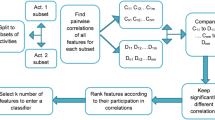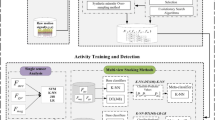Abstract
Real-time data with redundant and irrelevant features can degrade the performance of the classifier. Dataset with more number of features also increases the noise of the data and increases the time complexity of the learning algorithm. Feature selection is a solution for such problems where there is a need to reduce the dimensions of the data. In existing feature selection methods, the resultant feature sets can lead to local optima in the space of feature subsets. In this paper, ensemble-based feature selection approach is proposed to reduce size of the dataset and to improve classification accuracy. Results show that the proposed ensemble approach enhances the classifier performance, with reduced number of features.
Access this chapter
Tax calculation will be finalised at checkout
Purchases are for personal use only
Similar content being viewed by others
References
Chandrashekar G, Sahin F (2014) A survey on feature selection methods. Comput Electr Eng 40:16–28
Yaqub M, Javaid MK, Cooper C, Noble JA (2011) Improving the classification accuracy of the classic RF method by intelligent feature selection and weighted voting of trees with application to medical image segmentation. In: Suzuki K, Wang F, Shen D, Yan P (eds) Machine learning in medical imaging. lecture notes in computer science. Springer, Berlin, Heidelberg, 7009
Quiroz JC, Banerjee A, Dascalu SM, Lau SL (2017) Feature selection for activity recognition from smartphone accelerometer data feature selection for activity recognition from smartphone accelerometer data. Intell Automation Soft Comput 1–9
Zimek A, Campello RJGB, Sander J (2014) Ensembles for unsupervised outlier detection. ACM SIGKDD Explorations Newsletter 15:11–22. http://doi.org/10.1145/2594473.2594476
Rokach L (2010) Ensemble based classifiers. Artif Intell Rev 33:1–39. https://doi.org/10.1007/s10462-009-9124-7
Pérez RR, Silva AF (2015) Ensemble features selection method as tool for breast cancer classification Isabel Ramos. Int J Image Mining 1:224–244
Goh J, Thing VLL (2015) A hybrid evolutionary algorithm for feature and ensemble selection in image tampering detection. Int J Electron Secur Digit Forensics 7:76–104
Guru DS, Suhil M, Pavithra SK, Priya GR (2018) Ensemble of feature selection methods for text classification: an analytical study. In: Abraham A, Muhuri P, Muda A, Gandhi N (eds) Intelligent systems design and applications 2017. Advances in Intelligent Systems and Computing. Springer, 736, 337–349
Peng H, Long F, Ding C (2005) Feature selection based on mutual information criteria of max-dependency, max-relevance, and min-redundancy. Pattern Anal Mach Intell 27:1226–1238. https://doi.org/10.1109/tpami.2005.159
Lee C, Lee GG (2006) Information gain and divergence-based feature selection for machine learning-based text categorization. Info Process Manag 42(1):155–165
Song F, Guo X, Mei D (2010) Feature selection using principal component analysis. In: International conference on system science, engineering design and manufacturing informatization, IEEE society, 27–30
Author information
Authors and Affiliations
Corresponding author
Editor information
Editors and Affiliations
Rights and permissions
Copyright information
© 2020 Springer Nature Singapore Pte Ltd.
About this paper
Cite this paper
Gopalakrishnan, N., Krishnan, V., Gopalakrishnan, V. (2020). Ensemble Feature Selection to Improve Classification Accuracy in Human Activity Recognition. In: Ranganathan, G., Chen, J., Rocha, Á. (eds) Inventive Communication and Computational Technologies. Lecture Notes in Networks and Systems, vol 89. Springer, Singapore. https://doi.org/10.1007/978-981-15-0146-3_51
Download citation
DOI: https://doi.org/10.1007/978-981-15-0146-3_51
Published:
Publisher Name: Springer, Singapore
Print ISBN: 978-981-15-0145-6
Online ISBN: 978-981-15-0146-3
eBook Packages: EngineeringEngineering (R0)




